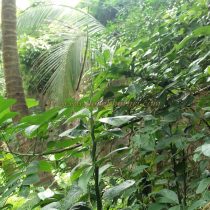MAHIM BURUJ
TYPE : COASTAL FORT
DISTRICT : PALGHAR
HEIGHT : 0
GRADE : EASY
Kelve beach on the Western Railway is famous among Mumbaikars. Mahim village is 10 km away from Kelve or Palghar station by rickshaw or S.T bus. After entering the main road, one can see a road going to the beach a little before going to Mahim fort. On the left side of this road, you can see Mahim Futka Buruj in a fence. The bastion is a circular watchtower. As the name of this bastion is not known in history and it is in a dilapidated condition, it is known as Mahim Futka Buruj by the name of Mahim village. There is a temple of Goddess Mahikavati in this village and the name Mahim is derived from this goddess. To the west of Mahim Futka Buruj is the sea and to the south is Mahim Bay. This ancient bastion which was on the coast is now far away from the sea like the fort of Kelve due to siltation and is on the verge of extinction.
...
At present, the height of this bastion is about 10 to 12 feet high, but previously it should be 20 to 25 feet. Rough stone, mud, and conch shells have been used for the construction of this circle-shaped bastion. The staircase is not present to climb the fort rather you have to climb a ladder. The foundation of a building is constructed in the upper part of the bastion using wrought stone. It must have been used to monitor the sea lanes and intercepted oncoming enemy boats with long-range cannons. The bastion was built by the Portuguese in the 16th century along with other forts in the area. Using all these small forts, watchtowers, and long-range cannons, the Portuguese established their empire on the sea lanes of North Konkan. The main use of these warehouses and watchtowers, built by the Portuguese, was to provide protection and necessary supplies to small and large forts in the province of Dativare to Manor. Chatrapati Sambhaji Maharaj had attacked Mahim in 1684, but the area was not captured as the Marathas did not have enough time to lay siege. After the conquest of Mahim fort in the Vasai campaign of 1739, the area came under the control of the Marathas on 10 January 1739 and the Portuguese were wiped out from the area. This fort remained with the Marathas until 1818 when it was conquered by the British. People coming here with an expectation to see a fort are likely to be upset, but if you want to see the Portuguese outpost on the ancient maritime trade route and its geographical importance, you cant visit this place. This bastion is small and can be seen in ten minutes.
© Suresh Nimbalkar




